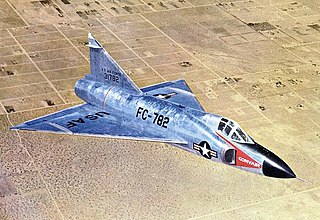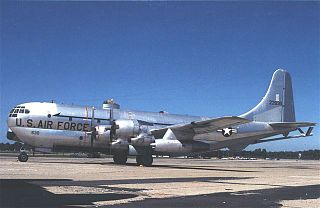Thailand

- F-84G
- 51-10582 Ex-USAF and retired Royal Thai Air Force fighter in Royal Thai Air Force Museum
A total of 4457 Republic F-84 Thunderjet jet fighters were built, [1] serving with 14 airforces. [2] Many examples are preserved and on display around the world, often in aviation museums.





The McDonnell Douglas F-15 Eagle is an American twin-engine, all-weather tactical fighter aircraft designed by McDonnell Douglas. Following reviews of proposals, the United States Air Force (USAF) selected McDonnell Douglas's design in 1969 to meet the service's need for a dedicated air superiority fighter. The Eagle first flew in July 1972, and entered service in 1976. It is among the most successful modern fighters, with over 100 victories and no losses in aerial combat, with the majority of the kills by the Israeli Air Force.

The Lockheed P-80 Shooting Star was the first jet fighter used operationally by the United States Army Air Forces (USAAF) during World War II. Designed and built by Lockheed in 1943 and delivered just 143 days from the start of design, production models were flying, and two pre-production models did see very limited service in Italy just before the end of World War II. Designed with straight wings, the type saw extensive combat in Korea with the United States Air Force (USAF) as the F-80.

The General Dynamics F-111 Aardvark is a retired supersonic, medium-range, multirole combat aircraft. Production models of the F-111 had roles that included attack, strategic bombing, reconnaissance and electronic warfare. Aardvark comes from a South African animal that has a long nose and hugs the terrain. It is an Afrikaans word that translates literally as "earth pig" — hence the aircraft's "Pig" nickname during its Australian service.

The North American F-100 Super Sabre is an American supersonic jet fighter aircraft designed and produced by the aircraft manufacturer North American Aviation. The first of the Century Series of American jet fighters, it was the first United States Air Force (USAF) fighter capable of supersonic speed in level flight.

The Convair F-102 Delta Dagger was an interceptor aircraft designed and produced by the American aircraft manufacturer Convair. A member of the Century Series, the F-102 was the first operational supersonic interceptor and delta-wing fighter operated by the United States Air Force (USAF).

The Republic F-84 Thunderjet was an American turbojet fighter-bomber aircraft. Originating as a 1944 United States Army Air Forces (USAAF) proposal for a "day fighter", the F-84 first flew in 1946. Although it entered service in 1947, the Thunderjet was plagued by so many structural and engine problems that a 1948 U.S. Air Force review declared it unable to execute any aspect of its intended mission and considered canceling the program. The aircraft was not considered fully operational until the 1949 F-84D model and the design matured only with the definitive F-84G introduced in 1951. In 1954, the straight-wing Thunderjet was joined by the swept-wing F-84F Thunderstreak fighter and RF-84F Thunderflash photo reconnaissance aircraft.

Alexander Kartveli, born Aleksandre Kartvelishvili, was a Georgian aeronautical engineer and an aviation pioneer in the United States. Kartveli achieved important breakthroughs in military aviation in the time of turbojet fighters.

The Northrop F-89 Scorpion is an all-weather, twin-engined interceptor aircraft designed and produced by the American aircraft manufacturer Northrop Corporation. It was the first jet-powered aircraft to be designed for the interceptor role from the outset to enter service, as well as the first combat aircraft to be armed with air-to-air nuclear weapons in the form of the unguided Genie rocket. The name Scorpion came from the aircraft's elevated tail unit and high-mounted horizontal stabilizer, which kept it clear of the engine exhaust.

The Martin B-57 Canberra is an American-built, twin-engined tactical bomber and reconnaissance aircraft that entered service with the United States Air Force (USAF) in 1953. The B-57 is a license-built version of the British English Electric Canberra, manufactured by the Glenn L. Martin Company. Initial Martin-built models were virtually identical to their British-built twinjet counterparts; Martin later modified the design to incorporate larger quantities of US-sourced components and produced the aircraft in several variants.

The Boeing KC-97 Stratofreighter is a four-engined, piston-powered United States strategic tanker aircraft based on the Boeing C-97 Stratofreighter. It replaced the KB-29 and was succeeded by the Boeing KC-135 Stratotanker.
The FICON program was conducted by the United States Air Force in the 1950s to test the feasibility of a Convair B-36 Peacemaker bomber carrying a Republic F-84 Thunderflash parasite fighter in its bomb bay. Earlier wingtip coupling experiments included Tip Tow, which were attempts at carrying fighters connected to the wingtips of bombers. Tom-Tom followed the FICON project afterwards.

The Republic F-84F Thunderstreak was an American swept-wing turbojet-powered fighter-bomber. The RF-84F Thunderflash was a photo reconnaissance version.

The Fairchild Republic A-10 Thunderbolt II is a single-seat, twin-turbofan, straight-wing, subsonic attack aircraft developed by Fairchild Republic for the United States Air Force (USAF). In service since 1977, it is named after the Republic P-47 Thunderbolt, but is commonly referred to as the "Warthog" or simply "Hog". The A-10 was designed to provide close air support (CAS) to ground troops by attacking enemy armored vehicles, tanks, and other ground forces; it is the only production-built aircraft designed solely for CAS to have served with the U.S. Air Force. Its secondary mission is to direct other aircraft in attacks on ground targets, a role called forward air controller-airborne; aircraft used primarily in this role are designated OA-10.

The 136th Operations Group is a component of the 136th Airlift Wing of the Texas Air National Guard. It was first activated in June 1943 as the 368th Fighter Group. After training with Republic P-47 Thunderbolts in the United States, it deployed to the European Theater of Operations, where it began combat operations in March 1944. Shortly after D-Day, the group moved to the continent of Europe, continuing operations until May 1945. The group was awarded the Distinguished Unit Citation and the Belgian Fourragère for its combat operations and being credited with the destruction of 120 enemy aircraft in air to air combat. It served in the occupation forces until the spring of 1946, when it inactivated and transferred its personnel and equipment to another unit.